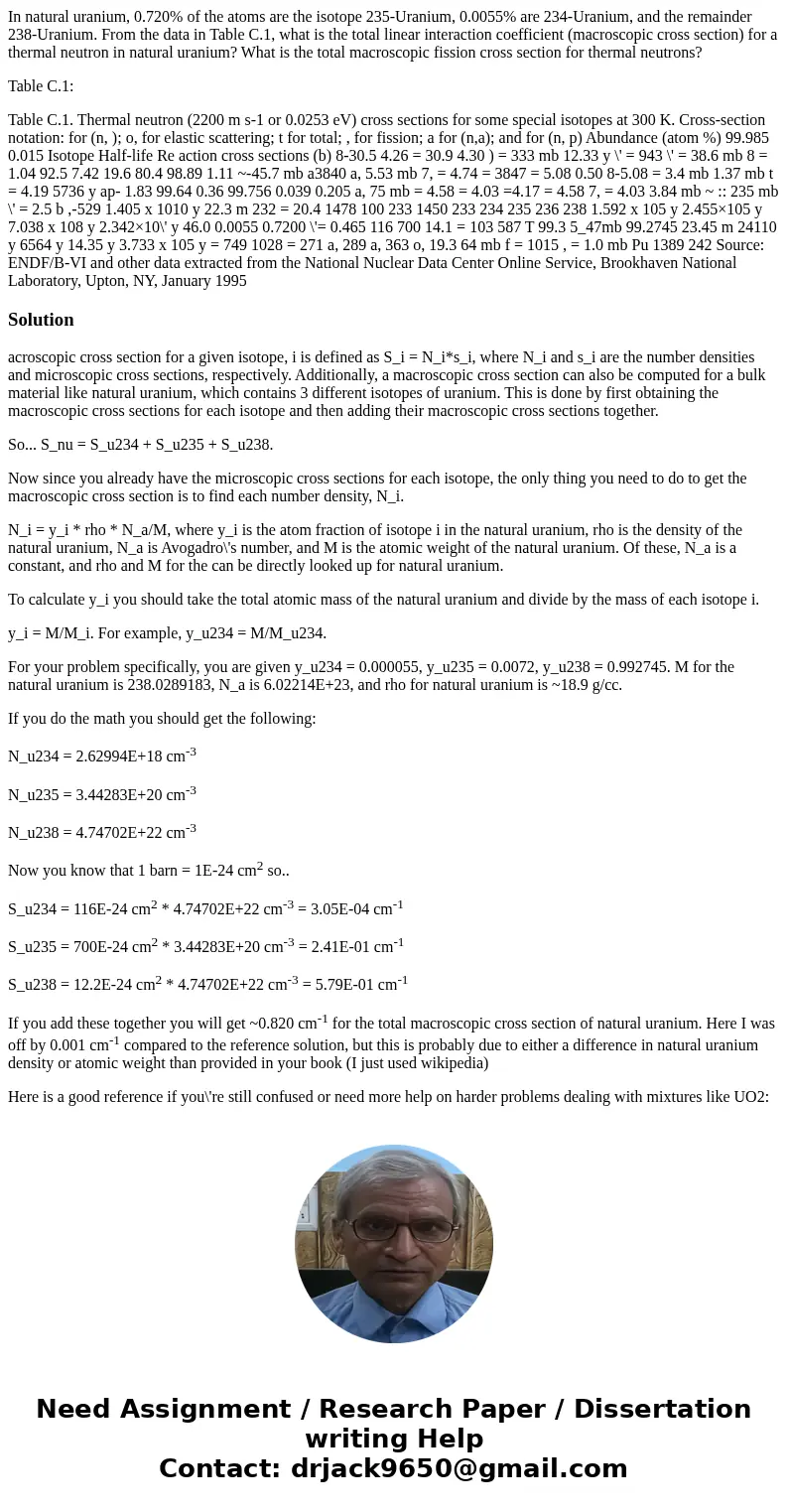In natural uranium 0720 of the atoms are the isotope 235Uran
In natural uranium, 0.720% of the atoms are the isotope 235-Uranium, 0.0055% are 234-Uranium, and the remainder 238-Uranium. From the data in Table C.1, what is the total linear interaction coefficient (macroscopic cross section) for a thermal neutron in natural uranium? What is the total macroscopic fission cross section for thermal neutrons?
Table C.1:
Table C.1. Thermal neutron (2200 m s-1 or 0.0253 eV) cross sections for some special isotopes at 300 K. Cross-section notation: for (n, ); o, for elastic scattering; t for total; , for fission; a for (n,a); and for (n, p) Abundance (atom %) 99.985 0.015 Isotope Half-life Re action cross sections (b) 8-30.5 4.26 = 30.9 4.30 ) = 333 mb 12.33 y \' = 943 \' = 38.6 mb 8 = 1.04 92.5 7.42 19.6 80.4 98.89 1.11 ~-45.7 mb a3840 a, 5.53 mb 7, = 4.74 = 3847 = 5.08 0.50 8-5.08 = 3.4 mb 1.37 mb t = 4.19 5736 y ap- 1.83 99.64 0.36 99.756 0.039 0.205 a, 75 mb = 4.58 = 4.03 =4.17 = 4.58 7, = 4.03 3.84 mb ~ :: 235 mb \' = 2.5 b ,-529 1.405 x 1010 y 22.3 m 232 = 20.4 1478 100 233 1450 233 234 235 236 238 1.592 x 105 y 2.455×105 y 7.038 x 108 y 2.342×10\' y 46.0 0.0055 0.7200 \'= 0.465 116 700 14.1 = 103 587 T 99.3 5_47mb 99.2745 23.45 m 24110 y 6564 y 14.35 y 3.733 x 105 y = 749 1028 = 271 a, 289 a, 363 o, 19.3 64 mb f = 1015 , = 1.0 mb Pu 1389 242 Source: ENDF/B-VI and other data extracted from the National Nuclear Data Center Online Service, Brookhaven National Laboratory, Upton, NY, January 1995Solution
acroscopic cross section for a given isotope, i is defined as S_i = N_i*s_i, where N_i and s_i are the number densities and microscopic cross sections, respectively. Additionally, a macroscopic cross section can also be computed for a bulk material like natural uranium, which contains 3 different isotopes of uranium. This is done by first obtaining the macroscopic cross sections for each isotope and then adding their macroscopic cross sections together.
So... S_nu = S_u234 + S_u235 + S_u238.
Now since you already have the microscopic cross sections for each isotope, the only thing you need to do to get the macroscopic cross section is to find each number density, N_i.
N_i = y_i * rho * N_a/M, where y_i is the atom fraction of isotope i in the natural uranium, rho is the density of the natural uranium, N_a is Avogadro\'s number, and M is the atomic weight of the natural uranium. Of these, N_a is a constant, and rho and M for the can be directly looked up for natural uranium.
To calculate y_i you should take the total atomic mass of the natural uranium and divide by the mass of each isotope i.
y_i = M/M_i. For example, y_u234 = M/M_u234.
For your problem specifically, you are given y_u234 = 0.000055, y_u235 = 0.0072, y_u238 = 0.992745. M for the natural uranium is 238.0289183, N_a is 6.02214E+23, and rho for natural uranium is ~18.9 g/cc.
If you do the math you should get the following:
N_u234 = 2.62994E+18 cm-3
N_u235 = 3.44283E+20 cm-3
N_u238 = 4.74702E+22 cm-3
Now you know that 1 barn = 1E-24 cm2 so..
S_u234 = 116E-24 cm2 * 4.74702E+22 cm-3 = 3.05E-04 cm-1
S_u235 = 700E-24 cm2 * 3.44283E+20 cm-3 = 2.41E-01 cm-1
S_u238 = 12.2E-24 cm2 * 4.74702E+22 cm-3 = 5.79E-01 cm-1
If you add these together you will get ~0.820 cm-1 for the total macroscopic cross section of natural uranium. Here I was off by 0.001 cm-1 compared to the reference solution, but this is probably due to either a difference in natural uranium density or atomic weight than provided in your book (I just used wikipedia)
Here is a good reference if you\'re still confused or need more help on harder problems dealing with mixtures like UO2:


 Homework Sourse
Homework Sourse